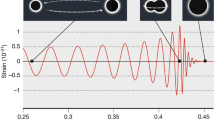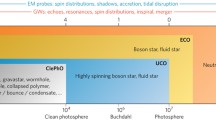Abstract
In the fuzzball paradigm the information paradox is resolved because the black hole is replaced by an object with no horizon. One may therefore ask if observations can distinguish a traditional hole from a fuzzball. We give arguments for why the fuzzball structure should lie close to the horizon; i.e., it should be a ‘tight’ fuzzball. We find: (a) It is very difficult to reflect quanta off the surface of such a fuzzball, mainly because geodesics starting near the horizon radius cannot escape to infinity unless their starting direction is very close to radial. (b) If infalling particles interact with the emerging radiation before they are engulfed by the horizon, then we say that we have a ‘firewall behavior’. We consider several types of interactions, but find no evidence for firewall behavior in any theory that obeys causality. (c) Photons with wavelengths larger than the black hole radius can be
scattered off the emerging radiation, but a very small fraction of the backscattered photons will be able to escape back to infinity.
Article PDF
Similar content being viewed by others
Avoid common mistakes on your manuscript.
References
S.W. Hawking, Particle Creation by Black Holes, Commun. Math. Phys. 43 (1975) 199 [Erratum ibid. 46 (1976) 206] [INSPIRE].
S.W. Hawking, Breakdown of Predictability in Gravitational Collapse, Phys. Rev. D 14 (1976) 2460 [INSPIRE].
O. Lunin and S.D. Mathur, AdS/CFT duality and the black hole information paradox, Nucl. Phys. B 623 (2002) 342 [hep-th/0109154] [INSPIRE].
S.D. Mathur, The Fuzzball proposal for black holes: An Elementary review, Fortsch. Phys. 53 (2005) 793 [hep-th/0502050] [INSPIRE].
K. Skenderis and M. Taylor, The fuzzball proposal for black holes, Phys. Rept. 467 (2008) 117 [arXiv:0804.0552] [INSPIRE].
I. Bena and N.P. Warner, Black holes, black rings and their microstates, Lect. Notes Phys. 755 (2008) 1 [hep-th/0701216] [INSPIRE].
I. Bena et al., Smooth horizonless geometries deep inside the black-hole regime, Phys. Rev. Lett. 117 (2016) 201601 [arXiv:1607.03908] [INSPIRE].
S.W. Hawking, Information loss in black holes, Phys. Rev. D 72 (2005) 084013 [hep-th/0507171] [INSPIRE].
S.D. Mathur, The Information paradox: A Pedagogical introduction, Class. Quant. Grav. 26 (2009) 224001 [arXiv:0909.1038] [INSPIRE].
J. Maldacena and L. Susskind, Cool horizons for entangled black holes, Fortsch. Phys. 61 (2013) 781 [arXiv:1306.0533] [INSPIRE].
S.B. Giddings, Nonviolent information transfer from black holes: A field theory parametrization, Phys. Rev. D 88 (2013) 024018 [arXiv:1302.2613] [INSPIRE].
S.W. Hawking, M.J. Perry and A. Strominger, Soft Hair on Black Holes, Phys. Rev. Lett. 116 (2016) 231301 [arXiv:1601.00921] [INSPIRE].
A. Almheiri, D. Marolf, J. Polchinski and J. Sully, Black Holes: Complementarity or Firewalls?, JHEP 02 (2013) 062 [arXiv:1207.3123] [INSPIRE].
S.D. Mathur and D. Turton, The flaw in the firewall argument, Nucl. Phys. B 884 (2014) 566 [arXiv:1306.5488] [INSPIRE].
H.A. Buchdahl, General Relativistic Fluid Spheres, Phys. Rev. 116 (1959) 1027 [INSPIRE].
S.D. Mathur, Emission rates, the correspondence principle and the information paradox, Nucl. Phys. B 529 (1998) 295 [hep-th/9706151] [INSPIRE].
G.W. Gibbons and N.P. Warner, Global structure of five-dimensional fuzzballs, Class. Quant. Grav. 31 (2014) 025016 [arXiv:1305.0957] [INSPIRE].
V. Cardoso and P. Pani, The observational evidence for horizons: from echoes to precision gravitational-wave physics, arXiv:1707.03021 [INSPIRE].
S.D. Mathur, Black Holes and Beyond, Annals Phys. 327 (2012) 2760 [arXiv:1205.0776] [INSPIRE].
A. Tyukov, R. Walker and N.P. Warner, Tidal Stresses and Energy Gaps in Microstate Geometries, JHEP 02 (2018) 122 [arXiv:1710.09006] [INSPIRE].
S.D. Mathur, Resolving the black hole causality paradox, arXiv:1703.03042 [INSPIRE].
S.D. Mathur, Spacetime has a “thickness”, Int. J. Mod. Phys. D 26 (2017) 1742002 [arXiv:1705.06407] [INSPIRE].
D. Marolf, private communication (2013).
S.D. Mathur, What prevents gravitational collapse in string theory?, Int. J. Mod. Phys. D 25 (2016) 1644018 [arXiv:1609.05222] [INSPIRE].
O. Lunin, J.M. Maldacena and L. Maoz, Gravity solutions for the D1-D5 system with angular momentum, hep-th/0212210 [INSPIRE].
I. Bena and N.P. Warner, One ring to rule them all . . . and in the darkness bind them?, Adv. Theor. Math. Phys. 9 (2005) 667 [hep-th/0408106] [INSPIRE].
S.D. Mathur and D. Turton, Oscillating supertubes and neutral rotating black hole microstates, JHEP 04 (2014) 072 [arXiv:1310.1354] [INSPIRE].
V. Cardoso, O.J.C. Dias, J.L. Hovdebo and R.C. Myers, Instability of non-supersymmetric smooth geometries, Phys. Rev. D 73 (2006) 064031 [hep-th/0512277] [INSPIRE].
B.D. Chowdhury and S.D. Mathur, Radiation from the non-extremal fuzzball, Class. Quant. Grav. 25 (2008) 135005 [arXiv:0711.4817] [INSPIRE].
B.D. Chowdhury and S.D. Mathur, Pair creation in non-extremal fuzzball geometries, Class. Quant. Grav. 25 (2008) 225021 [arXiv:0806.2309] [INSPIRE].
B.D. Chowdhury and S.D. Mathur, Non-extremal fuzzballs and ergoregion emission, Class. Quant. Grav. 26 (2009) 035006 [arXiv:0810.2951] [INSPIRE].
V. Cardoso, E. Franzin and P. Pani, Is the gravitational-wave ringdown a probe of the event horizon?, Phys. Rev. Lett. 116 (2016) 171101 [Erratum ibid. 117 (2016) 089902] [arXiv:1602.07309] [INSPIRE].
K. Papadodimas and S. Raju, An Infalling Observer in AdS/CFT, JHEP 10 (2013) 212 [arXiv:1211.6767] [INSPIRE].
L. Susskind, L. Thorlacius and J. Uglum, The Stretched horizon and black hole complementarity, Phys. Rev. D 48 (1993) 3743 [hep-th/9306069] [INSPIRE].
L. Susskind, String theory and the principles of black hole complementarity, Phys. Rev. Lett. 71 (1993) 2367 [hep-th/9307168] [INSPIRE].
G. ’t Hooft, The Holographic principle: Opening lecture, Subnucl. Ser. 37 (2001) 72 [hep-th/0003004] [INSPIRE].
S.D. Mathur, A model with no firewall, arXiv:1506.04342 [INSPIRE].
S.D. Mathur and C.J. Plumberg, Correlations in Hawking radiation and the infall problem, JHEP 09 (2011) 093 [arXiv:1101.4899] [INSPIRE].
S.D. Mathur, Tunneling into fuzzball states, Gen. Rel. Grav. 42 (2010) 113 [arXiv:0805.3716] [INSPIRE].
S.D. Mathur, How fast can a black hole release its information?, Int. J. Mod. Phys. D 18 (2009) 2215 [arXiv:0905.4483] [INSPIRE].
P. Kraus and S.D. Mathur, Nature abhors a horizon, Int. J. Mod. Phys. D 24 (2015) 1543003 [arXiv:1505.05078] [INSPIRE].
I. Bena, D.R. Mayerson, A. Puhm and B. Vercnocke, Tunneling into Microstate Geometries: Quantum Effects Stop Gravitational Collapse, JHEP 07 (2016) 031 [arXiv:1512.05376] [INSPIRE].
A.J. Amsel, D. Marolf and A. Virmani, Collisions with Black Holes and Deconfined Plasmas, JHEP 04 (2008) 025 [arXiv:0712.2221] [INSPIRE].
T. Banks and W. Fischler, A Model for high-energy scattering in quantum gravity, hep-th/9906038 [INSPIRE].
W.G. Unruh, Absorption Cross-Section of Small Black Holes, Phys. Rev. D 14 (1976) 3251 [INSPIRE].
D.N. Page, Particle Emission Rates from a Black Hole: Massless Particles from an Uncharged, Nonrotating Hole, Phys. Rev. D 13 (1976) 198 [INSPIRE].
S.R. Das, G.W. Gibbons and S.D. Mathur, Universality of low-energy absorption cross-sections for black holes, Phys. Rev. Lett. 78 (1997) 417 [hep-th/9609052] [INSPIRE].
V. Cardoso, S. Hopper, C.F.B. Macedo, C. Palenzuela and P. Pani, Gravitational-wave signatures of exotic compact objects and of quantum corrections at the horizon scale, Phys. Rev. D 94 (2016) 084031 [arXiv:1608.08637] [INSPIRE].
J. Abedi, H. Dykaar and N. Afshordi, Echoes from the Abyss: Tentative evidence for Planck-scale structure at black hole horizons, Phys. Rev. D 96 (2017) 082004 [arXiv:1612.00266] [INSPIRE].
T. Hertog and J. Hartle, Observational Implications of Fuzzball Formation, arXiv:1704.02123 [INSPIRE].
U.-L. Pen and A.E. Broderick, Possible Astrophysical Observables of Quantum Gravity Effects near Black Holes, Mon. Not. Roy. Astron. Soc. 445 (2014) 3370 [arXiv:1312.4017] [INSPIRE].
Open Access
This article is distributed under the terms of the Creative Commons Attribution License (CC-BY 4.0), which permits any use, distribution and reproduction in any medium, provided the original author(s) and source are credited.
Author information
Authors and Affiliations
Corresponding author
Additional information
ArXiv ePrint: 1711.01617
Rights and permissions
Open Access This article is licensed under a Creative Commons Attribution 4.0 International License, which permits use, sharing, adaptation, distribution and reproduction in any medium or format, as long as you give appropriate credit to the original author(s) and the source, provide a link to the Creative Commons licence, and indicate if changes were made.
The images or other third party material in this article are included in the article’s Creative Commons licence, unless indicated otherwise in a credit line to the material. If material is not included in the article’s Creative Commons licence and your intended use is not permitted by statutory regulation or exceeds the permitted use, you will need to obtain permission directly from the copyright holder.
To view a copy of this licence, visit https://creativecommons.org/licenses/by/4.0/.
About this article
Cite this article
Guo, B., Hampton, S. & Mathur, S.D. Can we observe fuzzballs or firewalls?. J. High Energ. Phys. 2018, 162 (2018). https://doi.org/10.1007/JHEP07(2018)162
Received:
Accepted:
Published:
DOI: https://doi.org/10.1007/JHEP07(2018)162




